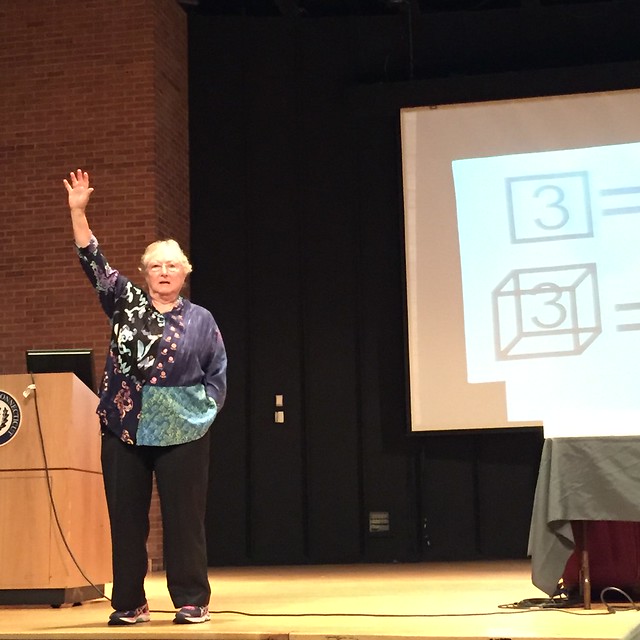Confratute Keynote - Rachel McAnallen aka Ms. Math
(I wrote up summaries of the keynotes at Confratute 2016 for the daily newsletter. I'll be posting those summaries with more information about each presenter here on my blog. Confratute is a yearly, week long conference for educators interested in enrichment learning. Want more information? Visit http://confratute.uconn.edu/)
 |
| Photo by Maria Selke - 2016 |
“I Won’t Mess With Your Comma If You Don’t Mess With My Decimal Point”
Rachel McAnallen’s passion for math has been a lifelong endeavor. When she decided to pursue a graduate degree in math education, she didn’t let anything stop her. She went back to grad school at 70! Rachel works with students and teachers all over the world as she seeks to improve mathematical understanding and teaching practices.
Rachel’s goal tonight was to help us understand how current instructional practices have caused many of the problems students have today. Most of these problems are tied into the fact that we don’t respect place value in numbers. Understanding and teaching how place value impacts every aspect of math is key to recreating our instructional strategies so students truly understand what numbers mean.
One key thing we do is incorrectly is move the decimal point all over the place. Rachel demonstrated this problem using the division problem 148 divided by 4. We all learned to start with “four doesn’t go into one”. That’s not one - it’s one hundred! We just moved the decimal point and disrespected the place value of the number. So then we say “How many times does four go into fourteen?” We moved the decimal again! It’s no wonder that kids are perplexed by those inconsistencies.
Another problem is teaching counterintuitive ways to add and subtract when we start addition on the right and when we regroup in subtraction. This isn’t how we count money or make change! It also leads to more misnaming of numbers and misunderstanding of place value.
We confuse children even more when we say things like “you can’t divide one by four” and “you can’t subtract a big number from a small one” and then a year or two later wonder why they scratch their heads over fractions and negative numbers.
Rachel suggested several things we can do that will help students gain deeper understanding of place value and mathematical processes. We need to show kids how to break numbers apart so they respect the decimal. We can model renaming those numbers in different ways. Challenge students to find their own ways to show a problem. You’ll be amazed at what they discover.
We also need to always provide context for our numbers. Numbers are adjectives and should always be connected nouns. Don’t give kids naked worksheets; always build the context. Understanding real world applications will help inform the way we teach addition and subtraction as well. Teaching that we can add cows plus cows, but not cows plus houses will help them later in algebra.
Rachel reminded us to commit to several key changes tonight. Let’s stop giving naked worksheets. Let’s be sure our number lines in every classroom includes negative numbers. This is a concept that all children can understand. Let’s keep asking “did anyone do it a different way?”. After all, “Arithmetic is answering the question - mathematics is questioning the answer.” Most importantly, let’s promise to call numbers by their correct place value names. Let’s take what we’ve learned back to our students and create a generation of mathematicians, not calculators.
Visit her website for great math resources and information
Learn more about Rachel!
.JPG)


Comments
Post a Comment